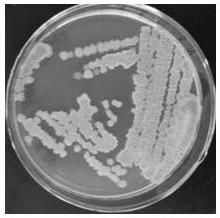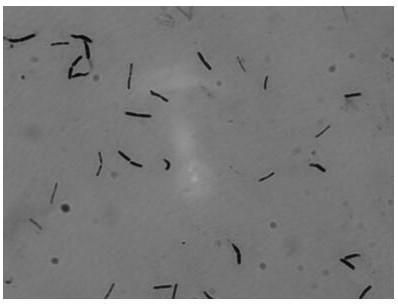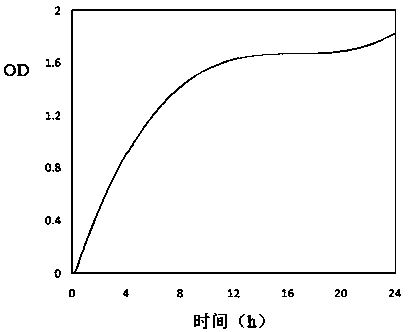A kind of biological agent for controlling clubroot of cruciferous crops and its application
A technology of cruciferous crops and biological preparations, applied in the field of applied microorganisms, can solve problems such as inability to increase crop yields, changes in microbial diversity, and poor soil microorganisms, and achieve low bacterial liquid application doses, low application concentrations, and simple operations Effect
- Summary
- Abstract
- Description
- Claims
- Application Information
AI Technical Summary
Problems solved by technology
Method used
Image
Examples
Embodiment 1
[0020] Embodiment 1: Bacillus amyloliquefaciens strain Bacillus amyloliquefaciens Screening Isolation of KM 68
[0021] LB medium formula: tryptone 10 g / L, yeast extract 5 g / L, sodium chloride 5 g / L, agarose 15 g / L; pH value is 7.4±0.1; Put it into a Erlenmeyer flask, sterilize it at 121°C under high temperature and high pressure, and pour it into a plate;
[0022] Weigh 1 g of the soil sample collected in Songming County, Yunnan Province, put it into a conical flask with glass beads filled with 50 mL of sterile water, shake it well for 30 min, and then use a pipette to draw 1 g from the conical flask. mL of the supernatant was added to another test tube filled with 9 mL of sterile water and mixed. According to this method, the diluted concentration was 10% of the concentration of the original solution. -3 、10 -4 、10 -5 times the soil solution, and spread 100 uL of the diluted soil solution on the LB medium plate, repeat 3 times for each dilution, culture on a shaker at ...
Embodiment 2
[0023] Embodiment 2: Bacillus amyloliquefaciens strain Bacillus amyloliquefaciens Morphology of KM 68
[0024] Preparation of Bacillus amyloliquefaciens Strains by Gradient Dilution Bacillus amyloliquefaciens For the bacterial suspension of KM 68, draw 10 uL of different dilutions of the bacterial suspension and spread it on the LB medium plate for cultivation. After 8-15 hours, the size, shape, surface, edge, color and properties such as transparency;
[0025] Different dilutions of Bacillus amyloliquefaciens strains were cultured on LB medium Bacillus amyloliquefaciens For KM 68, after culturing for 8-15 hours, draw 10uL of the bacterial suspension to make slices, and observe the strain of Bacillus amyloliquefaciens under an optical microscope Bacillus amyloliquefaciens The growth and morphological characteristics of KM 68;
[0026] Through culture and observation, the bacteria have the following characteristics: the colony is round or oval, wrinkled, slightly ...
Embodiment 3
[0027] Embodiment 3: Bacillus amyloliquefaciens strain Bacillus amyloliquefaciens Identification of 16s rDNA Gene Sequence of KM 68
[0028] After a single colony was inoculated in LB medium and cultured for 24 h, 1 uL was taken for colony PCR verification. The primers used for bacterial liquid PCR are as follows: Forward primer 27F: 5 , -AGAGTTTGATCMTGGCTCAG-3 , ; reverse primer 1492R: 5 , -GGTTACCTTGTTACGACTT-3 , . PCR reaction system: 10xTaq Buffer 2.5 uL, forward primer 0.5 uL, reverse primer 0.5 uL, bacterial solution 1 uL, dNTP (10 mmol / L) 0.5 uL, Taq DNA polymerase 0.5 U, add water to 25uL, PCR amplification conditions : After pre-denaturation at 94°C for 3 min, perform 35 cycles according to the program of 94°C, 30 s, 57°C, 120 s, 72°C, 90 s, and finally extend at 72°C for 10 min. Agarose gel electrophoresis was used for electrophoresis, the nucleic acid dye was EB, and the DNA Mark length was 2000. Finally, the PCR purified product was sent to Yunnan Shuoqing ...
PUM
 Login to View More
Login to View More Abstract
Description
Claims
Application Information
 Login to View More
Login to View More - R&D
- Intellectual Property
- Life Sciences
- Materials
- Tech Scout
- Unparalleled Data Quality
- Higher Quality Content
- 60% Fewer Hallucinations
Browse by: Latest US Patents, China's latest patents, Technical Efficacy Thesaurus, Application Domain, Technology Topic, Popular Technical Reports.
© 2025 PatSnap. All rights reserved.Legal|Privacy policy|Modern Slavery Act Transparency Statement|Sitemap|About US| Contact US: help@patsnap.com



